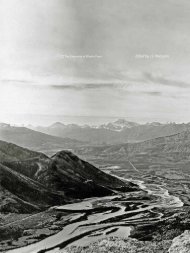C Ihe Ladies c cu. V'VVAN - History and Classics, Department of
C Ihe Ladies c cu. V'VVAN - History and Classics, Department of
C Ihe Ladies c cu. V'VVAN - History and Classics, Department of
- No tags were found...
You also want an ePaper? Increase the reach of your titles
YUMPU automatically turns print PDFs into web optimized ePapers that Google loves.
246 Notes to Pages 23-25Fort McMurray, was established as the railhead because itslocation, higher above the river, left it less susceptible t<strong>of</strong>looding (Aubrey, Place 76).poplars that were very tall <strong>and</strong> slender with silver stemsIt seems unusual that Vyvyan does not mention aspen, thedominant deciduous tree in the region; given this description,it may be that she does not distinguish one species <strong>of</strong> poplarfrom another.SS AthabascaIn 1883, when it built <strong>and</strong> launched the Grahame at FortChipewyan, the HBC began substituting steamers for its bigwooden supply boats, which had to be tracked upstream (Innis344 n8). Two years later, a steamer named Wriglry was built <strong>and</strong>launched at Fort Smith, <strong>and</strong> commenced service on the SlaveMackenzie waterway all the way to the Mackenzie Delta <strong>and</strong>Arctic Ocean. Thereafter, once northern travellers reached theAthabasca River watershed, their travel by steamer was relativelyunen<strong>cu</strong>mbered. The major obstacle never overcome, however,was twenty-five kilometres <strong>of</strong> the Slave River between fortsFitzgerald <strong>and</strong> Smith, where the river falls thirty metres over arocky projection <strong>of</strong> the Canadian Shield, causing a series <strong>of</strong>rapids, named Cassette, Pelican, Mountain, <strong>and</strong> Rapids <strong>of</strong> theDrowned (the correct order is seldom agreed upon [Back 67]).By the time <strong>of</strong>Vyvyan <strong>and</strong> Dorrien Smith's trip, the MackenzieRiver steamer could usually make three return trips betweenFort Smith <strong>and</strong> Aklavik each season. Steamboats plied theAthabasca <strong>and</strong> Mackenzie routes for six decades before theywere replaced by diesel tugs in 1947 (Ethel Stewart, "Early" 41).The SS Athabasca River, which was retired that year, measured 146feet in length; with a beam <strong>of</strong> 36 feet, it drew 3 feet <strong>of</strong> water. Itcould carry 150 tons <strong>of</strong> freight, h<strong>and</strong>le a 200-ton barge, travelat a speed <strong>of</strong> 13 knots, <strong>and</strong> provide saloon accommodations for58 passengers (Chalmers 70-3).The archdeacon ... had towed his wife <strong>and</strong> baby upriver in anEskiDlo skin boatCharles Edward Whittaker (1864-1947), who was born nearBurford, Ontario, was educated at Wycliffe College, Toronto<strong>and</strong> Stjohn's College, Winnipeg (''Whittaker''). Ordained in1896 <strong>and</strong> married in 1898 to Emma Hatley, sister to the wife <strong>of</strong>Bishop Lucas, he served as missionary to the Inuvialuit from1895 to 1917 ("Whittaker"), spending 1902-06 at St Patrick'sMission on Herschel Isl<strong>and</strong> (Saxberg 9). He later becamearchdeacon (Boon 232,451), <strong>and</strong> from 1918 to 1921 was rector<strong>of</strong> Christ Church, Whitehorse. In 1921, he <strong>and</strong> his wife left theYukon for Ontario, where he was rector <strong>of</strong> StJohn's, Cookstown(1921-23) <strong>and</strong> Stjames <strong>and</strong> All Saints, Penetanguishene(1923-30), although he periodically visited the Yukon("Whittaker"). He published one book, Arctic Eskimo (1937).On 28 March 19II, he <strong>of</strong>ficiated at the Fort McPherson burialservice for Francis Fitzgerald <strong>and</strong> the other mounties <strong>of</strong> thelost patrol Of19II (Steele 157).Portions <strong>of</strong> Whittaker's held notes from his trip up the RatRiver in 1900 are quoted in his memoir as follows:"Through the Company I bought an Eskimo skinboat,<strong>and</strong> engaged five men to take us over the Divide, arrangingfor the men's pay to be given them on their return. Laid inprovisions for twenty days for eight persons, with tent <strong>and</strong>other necessary camp gear. Also a large bag <strong>of</strong> moccasins,<strong>and</strong> store <strong>of</strong> tobacco , as these must be furnished the men,in addition to wages ...."Reached the first rapids early. A jagged stone <strong>cu</strong>t a holein the boat, which I plugged with my h<strong>and</strong>kerchief. Whenthrough the rapid, we hauled out <strong>and</strong> patched the boat,smearing the rent with tallow. We have sixty miles <strong>of</strong> thisstream ahead <strong>of</strong> us, passing an average <strong>of</strong> forty to hfty rapidsa day. We cook <strong>and</strong> eat morning, noon <strong>and</strong> night. The foodis mostly bannocks, made in a fryingpan [sic] over an openfire."Sunday-had a good rest, <strong>and</strong> sleep. Held service forthe boys, <strong>and</strong> prayers in our tent."Started early, though quite cold. Mother <strong>and</strong> daughter,with the baggage <strong>and</strong> supplies, with a steersman. oc<strong>cu</strong>py theboat, while the rest <strong>of</strong> us pull on the towline, or wadealongside the boat, to steady it in the boiling rapids, or easeit over the many stones in the frequent shallows."We are making good progress, but the food is diminishingrapidly. We counted on reaching the Divide in tendays, with no mishaps. At noon, I addressed the crew,promising them eleven days' wages if they could make it innine, <strong>and</strong> an extra day's pay for every day they could shortenthe trip. They accepted with good will."Mrs. Whittaker, tired <strong>of</strong>long sitting in the boat, wishedto walk along shore; so I carried Mabel, <strong>and</strong> we tramped,while the boys worked the boat. Soon our shore ended in a
















